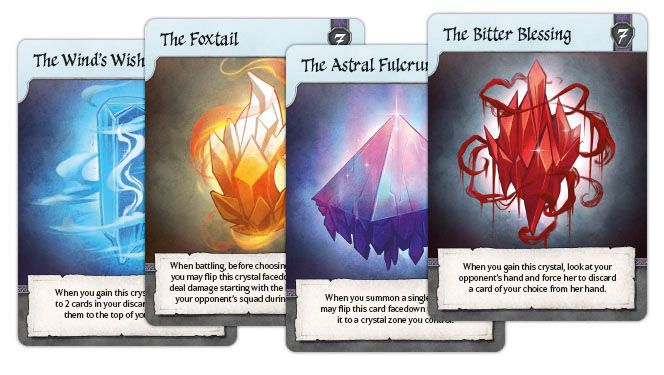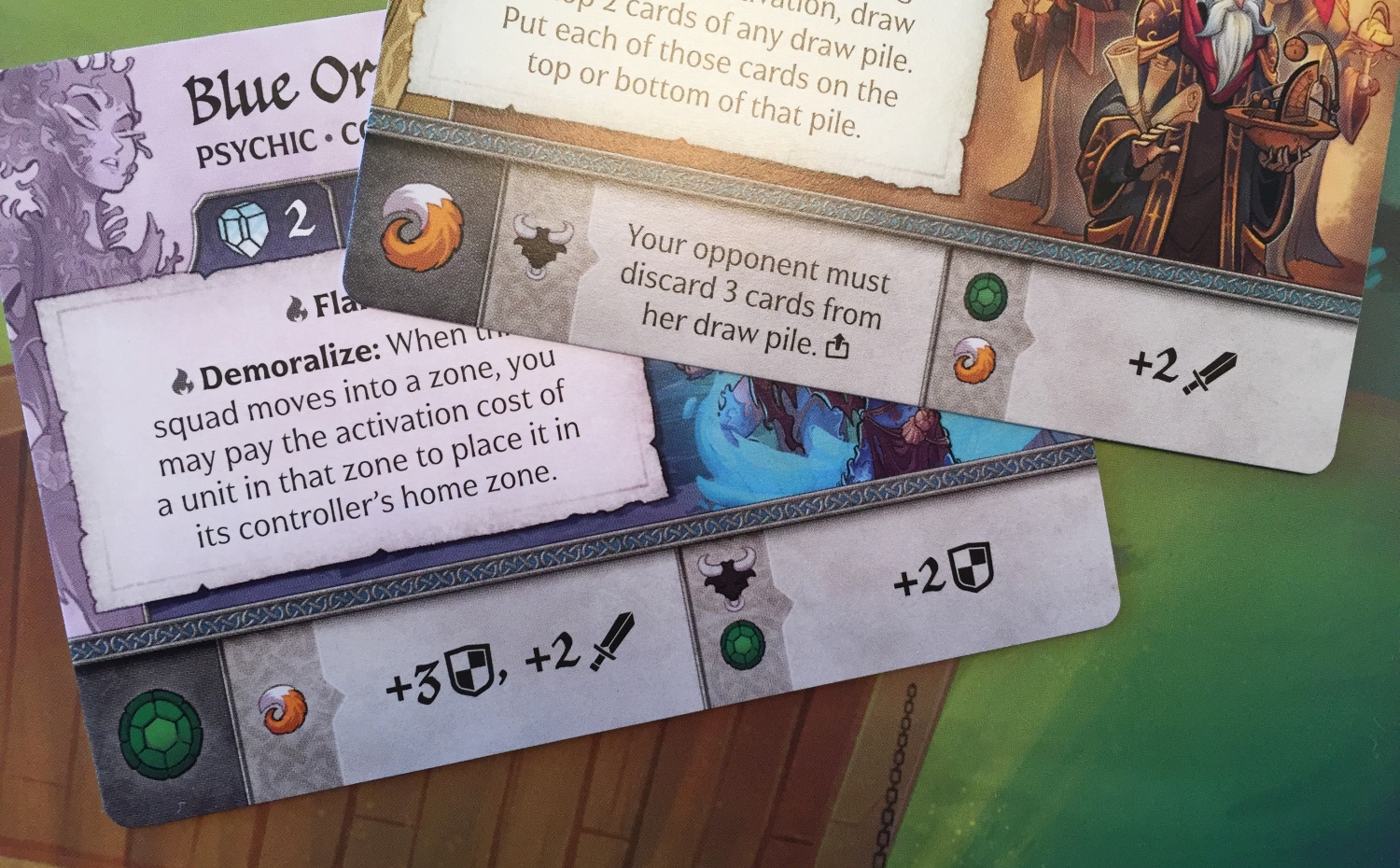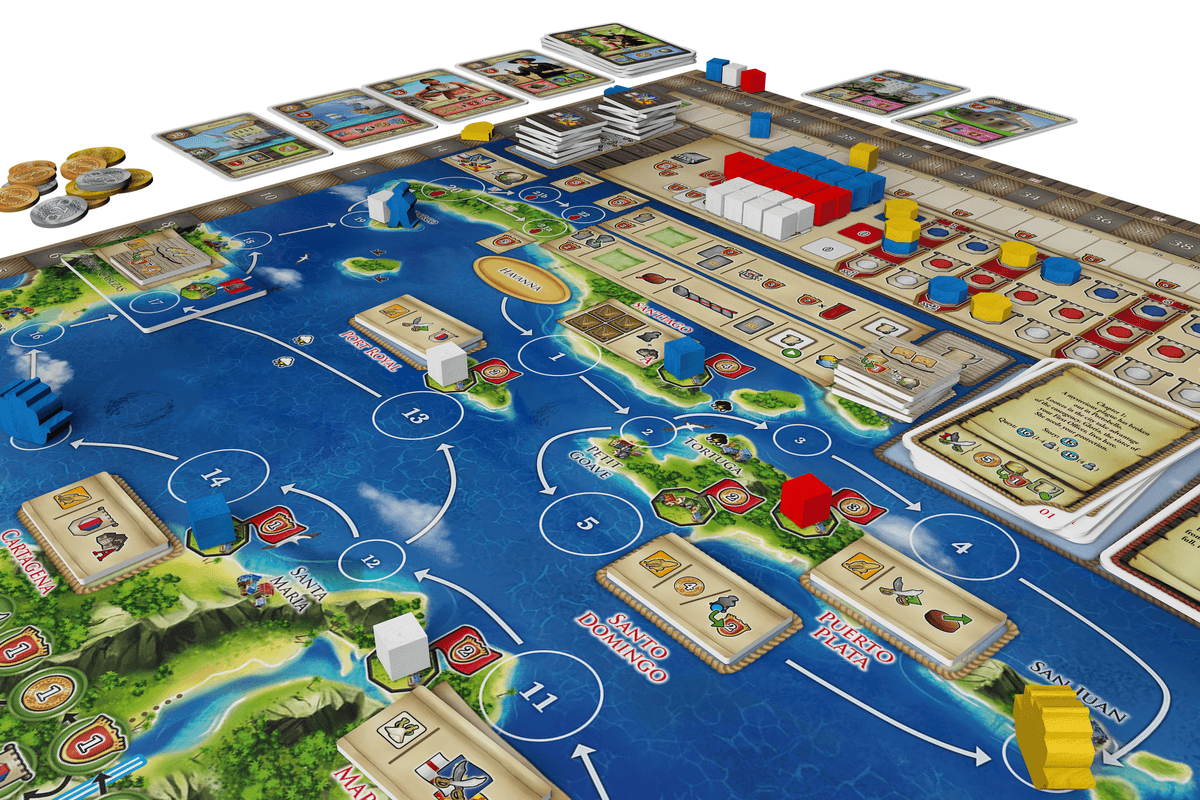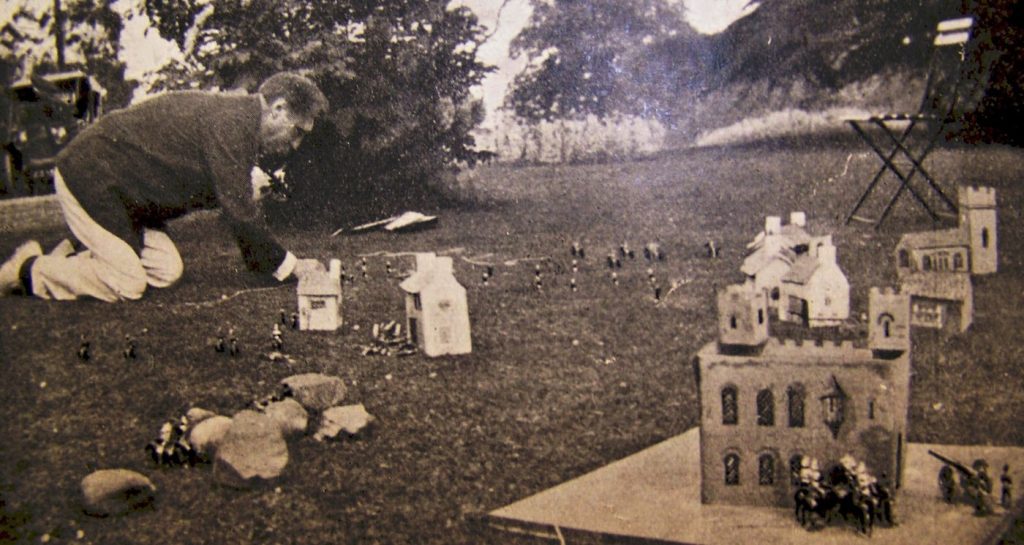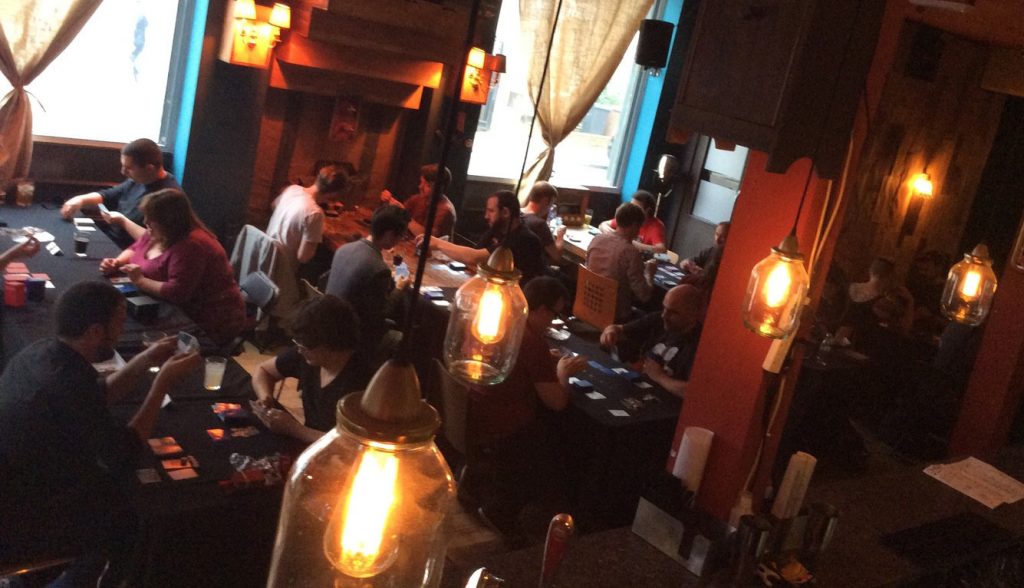Quinns: To look at the box of Crystal Clans, the new 2 player card game from publisher Plaid Hat, is to hear the soaring soundtrack of Saturday morning cartoons. The bracing breeze of GI Joe! The salty spray of the Thundercats-
Matt: Quinns this is a family show.
Quinns: It sure is, Matthew, and so is Crystal Clans! This box is a bat-signal that immediately summoned my childhood fascination with not just “fantasy” but the fantastical.
Contained within this game’s deliciously diverse clans are knights that ride bees into battle, necromancers who pursue a romantic Dia de los Muertos aesthetic, time-travelling twins and one massive crocodile. This feels like a world for everybody, and the manual doubles-down on that by using the feminine “She” to refer to the player.
Everything in Crystal Clans has a touch of the revolutionary about it, and that extends to the actual game. This is like no other box we’ve ever reviewed.
It works like this: First, two players each pick a clan with its own unique deck and thought-provoking play style. There are six clans in the base game, from the tiresome psychics of the Water Clan to the teeming hordes of the Skull Clan, but these are just for starters. Plaid Hat has already announced four more clans as imminent expansions, and they’ve stated that in the future they’ll be selling additional cards for each clan to let players customise their decks a little bit.
Once you’ve each picked a side, the game itself is a race to collect four crystals, a job that will require mastery of the numbered “Initiative track” running down the side of the board (seen above).
On your turn you can pay Initiative to take clansfolk from your hand and deploy them onto the board as a squad, you can pay initiative to move them around the board (and optionally fight the other clan’s squads), and if your squads control two of the board’s three “Crystal Zones” you can pay an exorbitant stack of initiative to collect one of the four crystals you need to win the game.
But here’s the twist: You can do any actions you want, one after the other, until you push the sparkly Initiative token onto your opponent’s side of the board, at which point it’s your opponent’s turn to do whatever she wants in whatever order she wishes. If you pay a whopping 9 initiative to claim a crystal or 11 initiative to summon a killer squad, there’s a sense of handing your opponent all the rope she needs to… not hang you, necessarily, but certainly to tangle your squads up in a lasso.
Fortunately, this isn’t the only way to get crystals. Each player’s deck also acts as a timer. Sure, you can play cards onto the board, or discard cards from your hand so you can draw different ones, or play cards to help you in fights, but every time your little 27 card deck runs out and you need to shuffle your discard pile to form a new draw deck? Your opponent gets a free crystal. The horror!
Oh, and I’ve saved my favourite mechanic for last. If a player sends a squad hiking all the way over to their opponent’s side of the board, those cards can “Invade” her castle to slice a wad of cards off of her deck. If your opponent gives you enough Initiative, sending a fast-moving, high-attack character sprinting down the field to the enemy castle to deliver a deathblow to her deck feels EXACTLY like scoring a goal in a football match. Boof!
Matt: Can I be mean now?
Quinns: Ack, is it that time already? I really wanted to like this game.
Matt: I did too! Crystal Clans is so immediately colourful and clever that to begin with, Quinns and I were puzzled as to why we weren’t having much fun playing it. The ideas and aesthetic sizzle and pop, but underneath the colourful exterior there’s a contest that feels stressful and unkind. You’ve been invited to live in Fraggle Rock, but they’d like you to help them to, well-
Quinns: Optimise their employee workflow?
Matt: Or to do their taxes, yeah.
But if Crystal Clans was just a game at odds with a theme, we could look past that. It’s more that this contrast is useful to describe quite how cold and pragmatic this game is. Decisions feel difficult, strategies feel strained, and satisfaction feels hard to come by. It’s rare that you feel truly committed to the tactical choices you make during the game – any flicker of pride sparked from bold decisions is immediately washed out by the floodlights of dread. Should you really have summoned that cool unit? Should you have taken that crystal now?
Quinns: Yeah. The good play in Crystal Clans is often the economic, conservative play- success against a skillful opponent will take every ounce of caution and care you can muster, and we found ourselves thinking about our turns for several minutes. But if you stop paying attention for one second, mistakes will lose you the game in a heartbeat. If you leave the wrong card as the leader of a squad that might mean their destruction, which could lead to giving your opponent board control, which could lead to them claiming their 3rd crystal, which would allow them to recklessly claim the 4th in a kamikaze play. Game over.
Matt: Yep. The apparent freedom offered by the initiative tracker is, in practice, almost the opposite. You can at any point make dramatically *big moves*, but whenever I did so I handed you such a huge boon that every ounce of my brain screamed “THIS WAS A MISTAKE”. Big plays let your opponent make similarly big plays, making Crystal Clans a game of not playing bravely or cunningly, but simply being correct, searching for the single most economic play. Which is, as you say, hard work.
I hope we’re being crystal clear when we say that nobody should buy Crystal Clans because they want to amass majickal gems with a gang of dandelion-wielding fairies. You should buy this game because you enjoy trapping your opponent in a cage of efficiencies.
Quinns: But that’s not right either! We need to talk about the combat cards. Another jigsaw piece that doesn’t quite fit together with the rest of the game.
Matt: Oh gosh, you’re right.
Quinns: So, whenever there’s a fight in Crystal Clans the players look at the strip running along the bottom of the cards in their hand. You each need to pick a card from your hand that is either Bold, Watchful or Tricky, and will have a different, unique effect on combat depending on whether it beats your opponent’s card in a rock-paper-scissors hierarchy.
So now we’ve got a game where you have to think carefully about every move… and yet when two squads fight, you can never be sure what’ll happen, so you can’t plan ahead. Also, while this theoretically makes a minigame out of predicting whether your opponent will play an aggressive, defensive or weird card, in practice players are often holding 1 or 0 cards in their hand (at which point they draw blindly off the deck), making this game of prediction… utterly unpredictable.
But worst of all, this system piles yet more numbers into Crystal Clans’ already-overburdened combat. Whenever two players flip their combat cards to see what happens, there’s rarely a cry of anguish or excitement, but rather the silence of two players figuring out what happened by adding and subtracting as many as sixteen integers spread across eight cards: Your strength of 2+(1×5)+4+4+2 minus my defense of 1+8+4+4, then my strength of 2+2+3+2 minus your defense of 8+4+3. Sums like these aren’t necessarily bad in a board game, but it’s hardly ideal to have them in the throat of every one of Crystal Clans’ most tense moments.
Matt: Yep. It’s a weirdly opaque system that demands a lot of consideration, yet where an unexpected card frequently slam-dunks your plans into a bin in a fashion in which no-one takes a great deal of pleasure because nobody planned it!
As a man who spends most of his life happily losing games, it’s striking how little fun failure is here: you’ll probably walk away with a gut sense of what you did to deserve a loss in a game of Crystal Clans, but all but the most competitive players are unlikely to want to put it into practice.
Quinns: I was definitely eager to play Crystal Clans for as long as it took me to try all six clans and see all of the art and ideas they contained, but after that my interest bottomed out.
Matt: Yeah. I didn’t dislike the time I spent with it, but I’ve absolutely no desire to get better at it, which is a death-knell for a competitive game. And for me, honestly, that feels *deeply unusual*. When we reviewed Tigris & Euphrates we waffled about the importance of appreciating “a fine move” – and I think that’s what’s crucially lacking here. If a player is better than you in this game, they’ll grind you down across thirty minutes of playing correctly and beating you at rock paper scissors. And if Crystal Clans isn’t much fun when you’re losing, it means it frequently isn’t fun for half the people playing. If you then want that same person to keep on playing with you, that might be a problem.
Quinns: And this is where I want to leap in and defend the game, because when two players are having a really close game, I’ve had moments where I’ve been able to see through the tangle of ideas to the design that I think Plaid Hat were aiming for.
A truly great game of Crystal Clans is a delicate, slow-motion fencing match. Each of you spends only as much initiative as you dare, deploying a squad here, advancing one there, only starting fights when you think you have the cards to come out of it better. And it has a really fabulous pace to it, too, where you have a series of small turns, followed by a couple of BIG TURNS that ROCK THE BOARD, followed by both players biding their time and waiting to see what happens.
Matt: And how often do games like that happen?
Quinns: Erm, in my experience? Well, when I started playing Crystal Clans that was about one game in three, but then I got better at the game than my friends and those close games that made the design sing dried up completely. Also, my friends don’t want to play with me anymore. But you and I could fix that! Do you wanna get good at the game together?
Matt: Not really! I don’t think it’s a bad game, it’s just not one I’m interested in playing.
Quinns: Yeah. I am really curious about the other clans they’re releasing, but I think that’s mostly because I want to see more of Martin Abel’s art.
That said, even the art’s made disappointingly small on the cards by the crush of mechanics around them. Which might be a bit of an apt metaphor for the game.
If you’re looking for a one vs. one fantasy card game that’s simpler, more accessible and infinitely more exciting than this one, Plaid Hat’s own Summoner Wars is still pots of fun. If you’ve not yet spent some time with that gem then you can’t go wrong picking up one of the two deck starter sets, and if you enjoy yourself you could splurge on the Alliances Master Set, a box containing a whopping eight decks.



